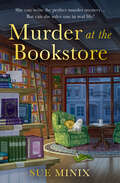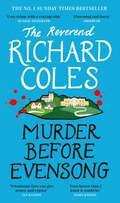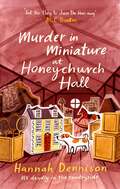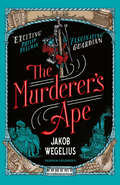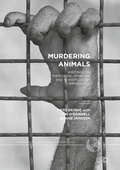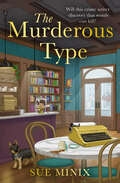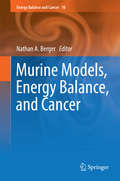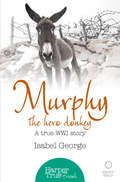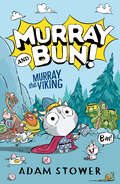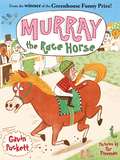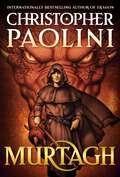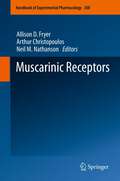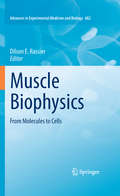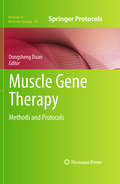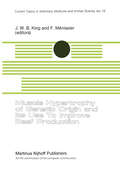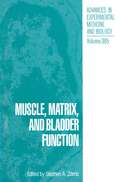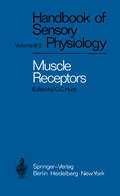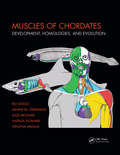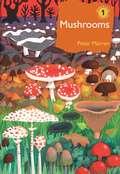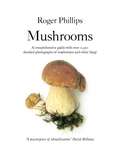- Table View
- List View
Murder at the Bookstore (The Bookstore Mystery Series)
by Sue Minix“A super cozy mystery… The perfect pick up for a weekend read by the fire. It has everything… Hijinks, who-dun-its, loveable characters, and a wonderful setting. And a main character who is FIERCE” NetGalley review ⭐⭐⭐⭐⭐ She can write the perfect murder mystery… But can she solve one in real life?
Murder at the Seaview Hotel: A murderer comes to Scarborough in this charming cosy crime mystery (A Helen Dexter Cosy Crime Mystery)
by Glenda Young'I loved this warm, humorous and involving whodunnit with its host of engaging characters and atmospheric Scarborough setting' Clare ChaseThe first in a page-turning new cosy crime series from Glenda Young, staring amateur sleuth Helen Dexter and her trusty greyhound Suki.This unputdownable whodunnit is perfect for fans of Julia Chapman's Dales Detective Agency, Richard Osman's The Thursday Murder Club, Betty Rowlands and Helen Cox.'An engaging murder mystery . . . an original and amusing hook which Glenda Young skilfully uses . . . to spin some intriguing plot twists' The Recs'A wholly entertaining mystery . . . a fun plot and plenty of wry humour' 5* reader review'Keeps you guessing . . . right till the end. A fantastic read that I didn't want to put down, beautifully written and amazing plot and characters' 5* reader review'A terrific tale' 5* reader review'A fantastic start to a new series . . . definitely a book you cannot put down' 5* reader reviewIn the charming Yorkshire seaside town of Scarborough, a murder is nothing to sing about . . .After the death of her husband Tom, Helen Dexter is contemplating her future as the now-sole proprietor of the Seaview Hotel.There's an offer from a hotel chain developer to consider, but also a booking from a group of twelve Elvis impersonators, a singing troupe called Twelvis. Tom loved Elvis and for Helen this is a sign that she should stay.But the series of mysterious events which follow, suggests that the developer is not going to give up easily. Then, shortly after Twelvis arrive, one of the group disappears. His body is found floating in a lake, with his blue suede shoes missing. Could the two be connected?With the reputation of the Seaview on the line, Helen isn't going to wait for the murderer to strike again. With her trusty greyhound Suki by her side, she decides to find out more about her guests and who wanted to make sure this Elvis never sang again.Helen and Suki return in Curtain Call at the Seaview Hotel - coming soon! Love Glenda Young's cosy crime? Don't miss her acclaimed Ryhope-set sagas, Belle of the Back Streets, The Tuppenny Child, Pearl of Pit Lane, The Girl with the Scarlet Ribbon, The Paper Mill Girl and The Miner's Lass.
Murder Before Evensong: A Canon Clement Mystery (Canon Clement Mystery)
by Reverend Richard ColesTHE FIRST NOVEL IN THE REVEREND RICHARD COLES' CANON CELEMENT MYSTERY SERIES'Britain's favourite vicar might be hanging up the dog collar, but in Murder Before Evensong he proves to be the unlikely heir to Barbara Pym'DAILY TELEGRAPH'I've been waiting for a novel with vicars, rude old ladies, murder and sausage dogs ... et voila!'DAWN FRENCH'Coles' rendering of his fictional church, St Mary's, in the village of Champton, twinkles with quirky detail and sharp humour'METRO 'Whodunnit fans can give praise and rejoice'IAN RANKIN 'A cunning whodunnit... This wise and often beautifully written novel remains most memorable as a sharp but sympathetic portrayal of everyday life in a small community and a clergyman's role within it' DAILY EXPRESS 'A warm funny joy from start to finish'SARAH MILLICAN'Cosy crime with a cutting edge'SUNDAY TELEGRAPH'You'll want to take a front row pew in Champton while this delicious series unfolds' JANICE HALLETT'A good old page-turner with brilliantly drawn characters... and dachshunds so real you can almost smell them'SAGA, Book of the Month 'An absolute joy from cover to cover - funny, clever and wonderfully plotted. Praise be!' ADAM KAY 'Coles' murderous take on a quintessentially English parish makes for a likeable, cosy crime caper'SUNDAY EXPRESS 'Champton joins St Mary Mead and Midsomer in the great atlas of fictional English villages where the crimes are as dastardly as the residents delightful. Only Richard Coles could pull this off so joyfully and with such style'DAMIAN BARR Canon Daniel Clement is Rector of Champton. He has been there for eight years, living at the Rectory alongside his widowed mother - opinionated, fearless, ever-so-slightly annoying Audrey - and his two dachshunds, Cosmo and Hilda.When Daniel announces a plan to install a lavatory in church, the parish is suddenly (and unexpectedly) divided: as lines are drawn, long-buried secrets come dangerously close to destroying the apparent calm of the village.And then Anthony Bowness - cousin to Bernard de Floures, patron of Champton - is found dead at the back of the church, stabbed in the neck with a pair of secateurs.As the police moves in and the bodies start piling up, Daniel is the only one who can try and keep his fractured community together... and catch a killer.
Murder in Miniature at Honeychurch Hall (Honeychurch Hall #8)
by Hannah DennisonWhen a body found on the Honeychurch Hall estate proves to be that of a villager who had supposedly moved to Ireland years earlier, tongues start wagging and theories abound. Charlie Green had always been a rogue.Although Charlie's demise happened well before Kat's arrival, Kat is drawn into the mystery when she finds two rare miniature portraits hidden inside a custom-made dollhouse of Honeychurch Hall. And then Charlie's aunt suffers a mysterious fatal fall and suspicion lands on a stranger who is holidaying in the newly installed shepherd's hut in the walled garden -- one of Lady Lavinia's latest hare-brained moneymaking schemes. Although there is something off about the tourist, Kat believes the culprit is fellow antique dealer.With tales of blackmail, infidelity and greed gripping the small community, past and present collide and Kat realises that the miniatures harbour a vital secret that one particular person is willing to kill for.
The Murderer's Ape
by Jakob WegeliusA captivating mystery adventure story, with gorgeously detailed black-and-white illustrations throughoutSally Jones is an extraordinary ape and a loyal friend. In overalls or in a maharaja's turban, this unique gorilla moves among humans without speaking but understanding everything. She and the Chief are devoted comrades who operate a cargo boat. A job they are offered pays big bucks, but the deal ends badly, and the Chief is falsely convicted of murder.For Sally Jones this is the start of a quest for survival and to clear the Chief's name. Powerful forces are working against her, and they will do anything to protect their own secrets.Jakob Wegelius is a Swedish writer and illustrator. The Murderer's Ape was a bestseller in Sweden and Germany, won the August Prize for Best Children's Book, the Nordic Council Children and Young People's Literature Prize, and is an International Youth Library White Raven selection.
Murdering Animals: Writings on Theriocide, Homicide and Nonspeciesist Criminology (Palgrave Studies in Green Criminology)
by Piers BeirneMurdering Animals confronts the speciesism underlying the disparate social censures of homicide and “theriocide” (the killing of animals by humans), and as such, is a plea to take animal rights seriously. Its substantive topics include the criminal prosecution and execution of justiciable animals in early modern Europe; images of hunters put on trial by their prey in the upside-down world of the Dutch Golden Age; the artist William Hogarth’s patriotic depictions of animals in 18th Century London; and the playwright J.M. Synge’s representation of parricide in fin de siècle Ireland. Combining insights from intellectual history, the history of the fine and performing arts, and what is known about today’s invisibilised sites of animal killing, Murdering Animals inevitably asks: should theriocide be considered murder? With its strong multi- and interdisciplinary approach, this work of collaboration will appeal to scholars of social and species justice in animal studies, criminology, sociology and law.
The Murderous Type (The Bookstore Mystery Series)
by Sue MinixI wrote murder mysteries. I didn’t investigate them. Until now…
Murine Models, Energy Balance, and Cancer (Energy Balance and Cancer #10)
by Nathan A. BergerThis volume provides a transdisciplinary and translational review of many of the leading murine models used to study the mechanisms, mediators and biomarkers linking energy balance to cancer. It provides a review of murine models that should be of interest to basic, clinical and applied research investigators as well as nutrition scientists and students that work in cancer prevention, cancer control and treatment. The worldwide obesity pandemic has been extensively studied by epidemiologic and observational studies and even, in some cases, by randomized controlled trials. However, the development and control of obesity, its comorbidities and its impact on cancer usually occurs over such long periods that it is difficult, if not impossible to conduct randomized controlled trials in humans to investigate environmental contributions to obesity, energy balance and their impact on cancer. In contrast, model organisms, especially mice and rats, provide valuable assets for performing these studies under rigorously controlled conditions and in sufficient numbers to provide statistically significant results. In this volume, many of the leading and new murine models used to study the mechanisms and mediators linking cancer with obesity, sleep, exercise, their modification by environment and how they may continue to be used to further elucidate these relations as well as to explore preclinical aspects of prevention and/or therapeutic intervention are considered. This volume provides an important compilation and analysis of major experimental systems and principles for further preclinical research with translational impact on energy balance and cancer.
Murphy the Hero Donkey: A True Ww1 Story (HarperTrue Friend – A Short Read)
by Isabel GeorgeThe remarkable true story of an amazing and loyal donkey during World War I.
Murray and Bun (Murray and Bun #1)
by Adam StowerADVENTURE LIES BEYOND THE CAT FLAP! Meet your favourite new duo: MURRAY AND BUN!Murray is a cat. Murray loves snoozing, fluffy blankets, and peace and quiet.Bun is a bun. Bun loves… EVERYTHING!And together they are unstoppable!
Murray the Race Horse: The Race Horse (Fables From The Stables Ser.)
by Gavin PuckettMurray the horse dreams of winning big races just like the rest of his family but he has one problem - he's just not that fast! When horse Ned Plumb twists his ankle at the start line, his jockey spots Murray in the crowd and says, 'Fancy a race?' Murray finally gets his chance to shine and beat the neigh-sayers with a rather unusual race technique...Written in winning verse, the accessible, bonkers writing in Murray the Horse will charm boys and girls age 7-11 (and horse-lovers of all ages), is complemented by Tor Freeman's hilarious illustrations, and has a great message about believing in yourself and following your dreams.
Murtagh: The World of Eragon (The Inheritance Cycle #5)
by Christopher PaoliniMaster storyteller and internationally bestselling author Christopher Paolini returns to the World of Eragon in this stunning epic fantasy set a year after the events of the Inheritance Cycle. The world is no longer safe for the Dragon Rider Murtagh and his dragon, Thorn. An evil king has been toppled, and they are left to face the consequences of the reluctant role they played in his reign of terror. Now they are hated and alone, exiled to the outskirts of society. Throughout the land, hushed voices whisper of brittle ground and a faint scent of brimstone in the air - and Murtagh senses that something wicked lurks in the shadows of Alagaësia. So begins an epic journey into lands both familiar and untravelled, where Murtagh and Thorn must use every weapon in their arsenal, from brains to brawn, to find and outwit a mysterious witch. A witch who is much more than she seems.In this gripping novel starring one of the most popular characters from Christopher Paolini's blockbuster Inheritance Cycle, a Dragon Rider must discover what he stands for in a world that has abandoned him. Murtagh is the perfect book to enter the World of Eragon for the first time . . . or to joyfully return.
Muscarinic Receptors (Handbook of Experimental Pharmacology #208)
by Allison D. Fryer, Arthur Christopoulos and Neil M. NathansonMuscarinic acetylcholine receptors have played a key role in the advancement of knowledge of pharmacology and neurotransmission since the inception of studies in these fields, and the effects of naturally occurring drugs acting on muscarinic receptors were known and exploited for both therapeutic and non-therapeutic purposes for hundreds of years before the existence of the receptors themselves was recognized. This volume presents a broad yet detailed review of current knowledge of muscarinic receptors that will be valuable both to long-time muscarinic investigators and to those new to the field. It describes the detailed insights that have been obtained on the structure, function, and cell biology of muscarinic receptors. This volume also describes physiological analyses of muscarinic receptors and their roles in regulating the function of the brain and of a variety of peripheral tissues. This volume shows how the study of muscarinic receptors continues to provide new and surprising insights not just to the cholinergic system but to the broad areas of neurobiology, cell biology, pharmacology, and therapeutics.
Muscle Biophysics: From Molecules to Cells (Advances in Experimental Medicine and Biology #682)
by Dilson E. RassierMuscle contraction has been the focus of scientific investigation for more than two centuries, and major discoveries have changed the field over the years. Early in the twentieth century, Fenn (1924, 1923) showed that the total energy liberated during a contraction (heat + work) was increased when the muscle was allowed to shorten and perform work. The result implied that chemical reactions during contractions were load-dependent. The observation underlying the “Fenn effect” was taken to a greater extent when Hill (1938) published a pivotal study showing in details the relation between heat production and the amount of muscle shortening, providing investigators with the force-velocity relation for skeletal muscles. Subsequently, two papers paved the way for the current paradigm in the field of muscle contraction. Huxley and Niedergerke (1954), and Huxley and Hanson (1954) showed that the width of the A-bands did not change during muscle stretch or activation. Contraction, previously believed to be caused by shortening of muscle filaments, was associated with sliding of the thick and thin filaments. These studies were followed by the classic paper by Huxley (1957), in which he conceptualized for the first time the cross-bridge theory; filament sliding was driven by the cyclical interactions of myosin heads (cross-bridges) with actin. The original cross-bridge theory has been revised over the years but the basic features have remained mostly intact. It now influences studies performed with molecular motors responsible for tasks as diverse as muscle contraction, cell division and vesicle transport.
Muscle Gene Therapy: Methods and Protocols (Methods in Molecular Biology #709)
by Dongsheng DuanGene therapy offers many conceptual advantages to treat muscle diseases, especially various forms of muscular dystrophies; however, it faces a number of unique challenges, including the need to deliver a therapeutic vector to all muscles throughout the body. In Muscle Gene Therapy: Methods and Protocols, expert researchers in the field present a collection of techniques aimed at bridging the translational gap in muscle gene therapy between the prevalent rodent models and vitally important larger animal models. Divided into three sections, this volume examines basic protocols for optimizing the muscle gene expression cassette and for evaluating the therapeutic outcomes, new developments in muscle gene therapy technology such as adeno-associated viral vector (AAV), oligonucleotide-mediated exon-skipping, and novel RNA-based strategies, and step-by-step guidance on muscle gene delivery in swine, ovine, canine, and non-human primates. Written in the highly successful Methods in Molecular Biology™ series format, chapters include introductions to their respective topics, lists of the necessary materials and reagents, detailed, readily reproducible laboratory protocols, and tips on troubleshooting and avoiding known pitfalls. Authoritative and cutting-edge, Muscle Gene Therapy: Methods and Protocols serves as an invaluable resource for graduate students, post-doctoral fellows, and principle investigators pursuing the crucial advancement of muscle disease gene therapy in the hope of someday curing these debilitating disorders.
Muscle Hypertrophy of Genetic Origin and its use to Improve Beef Production: A Seminar in the CEC Programme of Coordination of Research on Beef Production held in Toulouse, France, June 1–12, 1980 (Current Topics in Veterinary Medicine #16)
by J. W. B. King F. MénissierThis publication contains the proceedings of a seminar held in Toulouse, France, on 10th, 11th and 12th June 1980, under the auspices of the Commission of the European Communities, Directorate General for Agriculture, Division for the Coordination of Agricultural Research, as part of a programme of research on beef production. The seminar was intended to bring together available experience on the utilisation of hereditary muscular hypertrophy for meat production in the member states of the European Communities. Although the phenomenon of double muscling has been exploited in various countries, particularly France, Italy and Belgium, different breeds are used and different methods of exploitation employed. An attempt was therefore made to bring together the collective experience of participants. Contributions ranged from those on the inheritance of muscular hypertrophy to alternative production systems and from fundamental studies of muscle growth to practical ways of selling the additional musrile found in animals with muscular hypertrophy. The collection of assembled papers and discussions thus represents one of the most extensive reviews of the subject that has been attempted.
Muscle, Matrix, and Bladder Function (Advances in Experimental Medicine and Biology #385)
by Stephen A. ZdericThis conference and monograph were the result of many collective efforts. The whole concept was formulated one early Wednesday morning at our weekly research meeting at Children's Hospital in our division of urology. We have been most fortunate to have a close collaboration with Bob Levin, Ed Macarak, and Pam Howard who have helped steer the course of our division's growing interest in basic science. At our weekly meetings our laboratory fellow will summarize their current work. Other ongoing areas of investigation in our labs and elsewhere are discussed. We have always made an effort to try and understand what other groups are doing who are working in the area of bladder smooth muscle research. It occurred to us that the best way to really know what everyone working in this field was doing would be to sponsor a 2-day meeting where we could all gather to discuss our ongoing work. A major limitation of the annual meeting of the American Urologic Association or the urology section of the American Academy of Pediatrics is that the scientfic sessions are limited as these are meant to be primarily clinical meetings (as they should be). For this reason the idea of a meeting devoted solely to research about the urinary bladder had great appeal. In addition to allowing for longer presentations than the standard 5 to 7 minutes, every effort would be made to encourage a dialogue amongst the presenters and the audience.
Muscle Receptors (Handbook of Sensory Physiology #3 / 2)
by D. Barker C.C. Hunt A.K. McIntyreThis section will consider the structure and function of muscle receptors, as well as the central nervous system mechanisms with which they are concerned. In volume I of this Handbook, receptor mechanisms are discussed in detail. Also, the crustacean stretch receptor and the frog muscle spindle have been considered. The present section will be concerned with vertebrate muscle receptors with an emphasis on mammals. Muscle receptors provide interesting examples of specialized mechanorecep tors. The muscle spindle is a striking case of a receptor which is regulated in its function by the central nervous system in efferent neurons. Muscle receptors have long been known to playa crucial role in the reflex regulation of movement. In recent years it has become apparent that these receptors are also important in sensory phenomena such as the perception of position and movement. St. Louis, July 1974 c.c. HUNT Contents Chapter I The Morphology of Muscle Receptors. By D. BARKER. With 99 Figures . . . . . . . . . . . . . . . .. 1 Chapter II The Physiology of Muscle Receptors. By C.C. HUNT. With 21 Figures . . . . . . . . . . . . . . . . . 191 Chapter III Central Actions of Impulses in Muscle Afferent Fibres. By A. K. McINTYRE. With 8 Figures 235 Author Index 289 Subject Index 299 List of Contributors BARKER, David Department of Zoology, University of Durham, Science Laboratories, South Road, Durham DH1 3LE, Great Britain HUNT, Carlton C. Department of Physiology and Biophysics, Washington University, School of Medicine, 660 South Euclid Avenue, St. Louis, Mo. 63110, USA McINTYRE, A. K.
Muscle Receptors and Movement: Proceedings of a Symposium held at the Sherrington School of Physiology, St Thomas’s Hospital Medical School, London, on July 8th and 9th, 1980
by A. Taylor A. ProchazkaMuscles of Chordates: Development, Homologies, and Evolution
by Rui Diogo Janine M. Ziermann Julia Molnar Natalia Siomava Virginia AbdalaChordates comprise lampreys, hagfishes, jawed fishes, and tetrapods, plus a variety of more unfamiliar and crucially important non-vertebrate animal lineages, such as lancelets and sea squirts. This will be the first book to synthesize, summarize, and provide high-quality illustrations to show what is known of the configuration, development, homology, and evolution of the muscles of all major extant chordate groups. Muscles as different as those used to open the siphons of sea squirts and for human facial communication will be compared, and their evolutionary links will be explained. Another unique feature of the book is that it covers, illustrates, and provides detailed evolutionary tables for each and every muscle of the head, neck and of all paired and median appendages of extant vertebrates. Key Selling Features: Has more than 200 high-quality anatomical illustrations, including evolutionary trees that summarize the origin and evolution of all major muscle groups of chordates Includes data on the muscles of the head and neck and on the pectoral, pelvic, anal, dorsal, and caudal appendages of all extant vertebrate taxa Examines experimental observations from evolutionary developmental biology studies of chordate muscle development, allowing to evolutionarily link the muscles of vertebrates with those of other chordates Discusses broader developmental and evolutionary issues and their implications for macroevolution, such as the links between phylogeny and ontogeny, homology and serial homology, normal and abnormal development, the evolution, variations, and birth defects of humans, and medicine.
Muscles of Chordates: Development, Homologies, and Evolution
by Rui Diogo Janine M. Ziermann Julia Molnar Natalia Siomava Virginia AbdalaChordates comprise lampreys, hagfishes, jawed fishes, and tetrapods, plus a variety of more unfamiliar and crucially important non-vertebrate animal lineages, such as lancelets and sea squirts. This will be the first book to synthesize, summarize, and provide high-quality illustrations to show what is known of the configuration, development, homology, and evolution of the muscles of all major extant chordate groups. Muscles as different as those used to open the siphons of sea squirts and for human facial communication will be compared, and their evolutionary links will be explained. Another unique feature of the book is that it covers, illustrates, and provides detailed evolutionary tables for each and every muscle of the head, neck and of all paired and median appendages of extant vertebrates. Key Selling Features: Has more than 200 high-quality anatomical illustrations, including evolutionary trees that summarize the origin and evolution of all major muscle groups of chordates Includes data on the muscles of the head and neck and on the pectoral, pelvic, anal, dorsal, and caudal appendages of all extant vertebrate taxa Examines experimental observations from evolutionary developmental biology studies of chordate muscle development, allowing to evolutionarily link the muscles of vertebrates with those of other chordates Discusses broader developmental and evolutionary issues and their implications for macroevolution, such as the links between phylogeny and ontogeny, homology and serial homology, normal and abnormal development, the evolution, variations, and birth defects of humans, and medicine.
Mushrooms: The natural and human world of British fungi (British Wildlife Collection)
by Peter MarrenMushrooms, the first of a major new series of books on British natural history, provides a remarkable insight into the natural and human world of fungi. Peter Marren, in his inimitable, relaxed style, guides the reader through the extraordinary riches of this often overlooked group, from the amazing diversity of forms and lifestyles that populate the fungal landscape, to the pursuit of edible fungi for the pot, and the complexities of identification thrown up by our modern understanding of DNA. Throughout the book, the author tells a story rich in detail about how we have come to appreciate and, in some cases, fear the mushrooms and toadstools that are such an integral part of the changing seasons. Marren also provides a refreshingly candid view of our attempts to name species, the role of fungi in ecosystems, and our recent efforts to record and conserve them.
Mushrooms: The natural and human world of British fungi (British Wildlife Collection)
by Peter MarrenMushrooms, the first of a major new series of books on British natural history, provides a remarkable insight into the natural and human world of fungi. Peter Marren, in his inimitable, relaxed style, guides the reader through the extraordinary riches of this often overlooked group, from the amazing diversity of forms and lifestyles that populate the fungal landscape, to the pursuit of edible fungi for the pot, and the complexities of identification thrown up by our modern understanding of DNA. Throughout the book, the author tells a story rich in detail about how we have come to appreciate and, in some cases, fear the mushrooms and toadstools that are such an integral part of the changing seasons. Marren also provides a refreshingly candid view of our attempts to name species, the role of fungi in ecosystems, and our recent efforts to record and conserve them.
Mushrooms: A comprehensive guide to mushroom identification (A\pan Original Ser.)
by Roger Phillips'Roger Phillips has written the best mushroom book I know.' Hugh Fearnley-WhittingstallThe culmination of over thirty years' work, Roger Phillips's authoritative and superbly illustrated reference work is packed with the most up-to-date information and original photographs. The essential illustrated mycological encyclopedia, this book is also clear, user friendly and will appeal to a wide range of readers. Unsurpassed in both illustrative and descriptive detail, Mushrooms contains over 1,250 photographs, often showing the specimens in various stages of growth, and includes all the latest botanical and common names as well as current ecological information on endangered species. Having sold more than 750,000 copies in Europe of his previous title on mushrooms, Roger Phillips's Mushrooms once again sets the benchmark. Quite simply, nobody with an interest in the subject can afford to be without this book.
